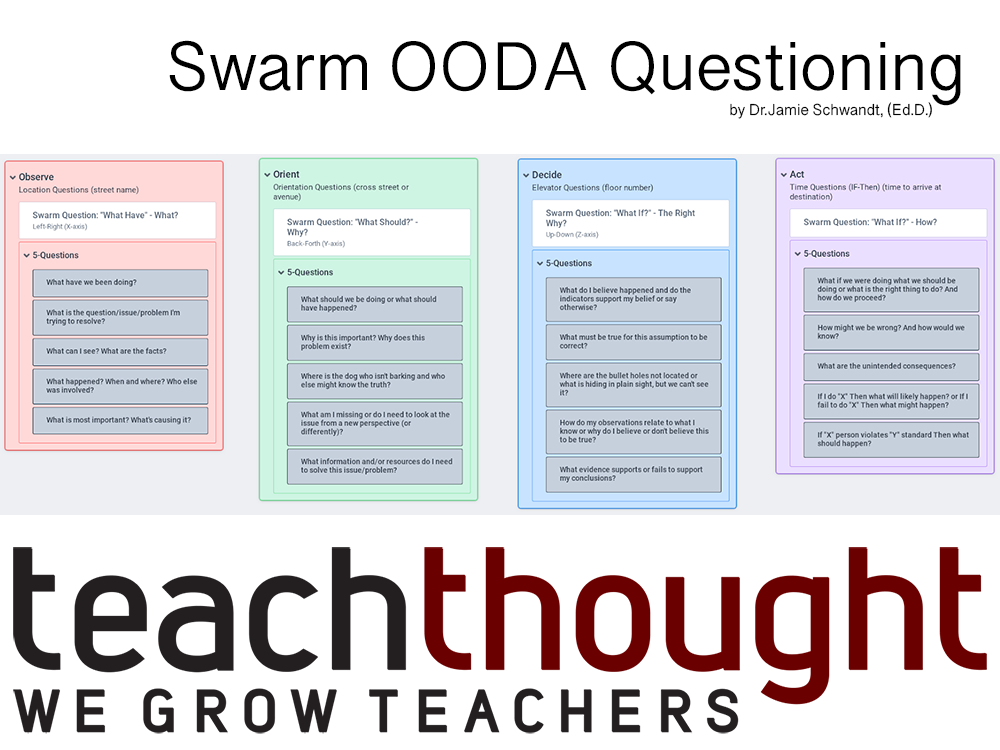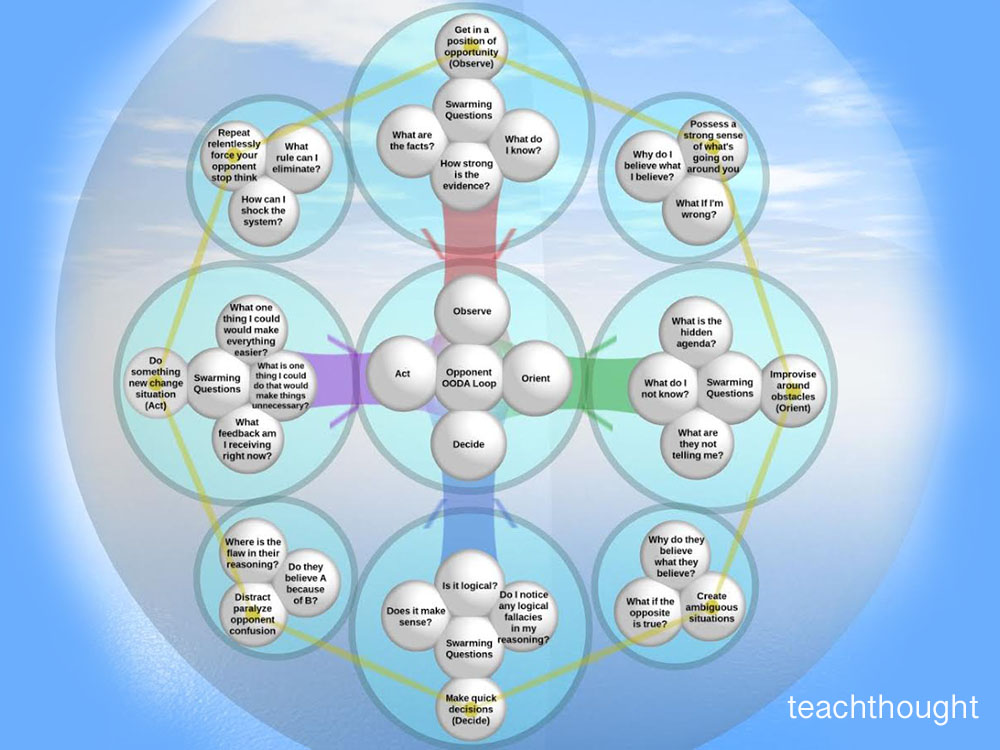
Four-Dimensional Questioning: An Overview
contributed by Dr. Jamie Schwandt, (Ed.D.)
Questioning is like a missile guidance system designed to attack a specific target; whereas, a question guidance system is designed to identify an exact issue, problem, or answer.
Dan Rothstein of the Right Question Institute sums it up nicely, “The way you ask a question yields different results and can lead you in different directions.”
Four-Dimensional Questioning is a continuation of a series of articles I have published on the topic of Swarm Questions and Swarm Learning. Swarm Questions are my question guidance system. Read the following articles for a deeper understanding of these ideas:
- Swarm Questions: What Have? What Should? What If?
- Swarm Learning: How Student Feedback Changes a Class In Progress
- Question Matrix: How to Develop the Right Questions
So, what exactly is Four-Dimensional Questioning? To answer this question, let’s examine two concepts: Three-dimensional and Four-dimensional space.
Three-dimensional space: is a geometric setting in which three values (called parameters) are required to determine the position of a point represented by coordinates: x, y, and z.
Four-dimensional space: is a mathematical extension of the concept of three-dimensional space. Single locations in 4D space are provided as vectors or ordered lists such as t, x, y, z.
I came across quick, yet phenomenal book that introduced me to an intriguing idea: Three Dimensions to Powerful Questions (construction, scope, and assumptions). I highly recommend The Art of Powerful Questions: Catalyzing Insight, Innovation, and Action by Eric E. Vogt, Juanita Brown, and David Isaacs. The authors describe the following dimensions:
- The First Dimension. This is the construction of a question and is critical in either opening our minds or narrowing the possibilities we can consider. Here we need to identify if our question is a yes/no, either/or, or an interrogative question, such as a Who, What, When, Where, Which, Why, How questions.
- The Second Dimension. This is the scope of a question, where the authors describe how it’s important to not only be aware of how the words we choose influence the effectiveness of our query, but also to match the scope of a question to our needs. These types of questions take the form of “How can we…”
- The Third Dimension. This is the assumption within questions. The authors state that almost all questions we pose have assumptions built into them, either explicit or implicit. They suggest that, to formulate powerful questions, it’s important to become aware of assumptions and use them appropriately. For example, contrast the following two questions: “What did we do wrong and who is responsible?” with “What can we learn from what’s happened and what possibilities do we now see? They posit that the second question encourages reflection and is more likely to stimulate learning and collaboration.
David Grove’s Basic Clean Language Questions provided another source of inspiration for my idea. Grove developed these questions as a way to help people focus on what they want to have happen and how to achieve it. For example:
- What would you like to have happen? (Desired Outcome)
- And what needs to happen for that desired outcome? (Conditions that must be in place)
- And can what needs to happen… happen? (Checking to see if they have the confidence to achieve it)
Additionally, the following books inspired my idea:
The Book of Beautiful Questions: The Powerful Questions That Will Help You Decide, Create, Connect, and Lead by Warren Berger
Ask More: The Power of Questions to Open Doors, Uncover Solutions, and Spark Change by Frank Sesno
For a fantastic resource and list of questions, I recommend downloading Warren Berger’s Q-Cards.
What Is Four-Dimensional Questioning?
“Many people confuse hypothesis with theories, thinking they’re one and the same. But a hypothesis comes before a theory or explanation. It’s the soil below the basement of thought.” – Frank Sesno
First, let’s look at a dimensional analogy from The Elegant Universe: Superstrings, Hidden Dimensions, and the Quest for the Ultimate Theory written by Brian Greene. Greene writes,
“In familiar language, you can specify a city address, say, by giving a street (location in the “left-right dimension”), a cross-street or an avenue (location in the “back-forth dimension”), and a floor number (location in the up-down dimension”). And from a more modern perspective, we have seen that Einstein’s work encourages us to think about time as another dimension (the “future-past dimension”), giving us a total of four dimensions (three space dimensions and one-time dimension). You specify events in the universe by telling where and when they occur.”
Similarly, we can use this thought process to develop Four-Dimensional Questioning in combination with Colonel John Boyd’s OODA Loop. According to Frans P.B. Osinga in Science, Strategy and War: The Strategic Theory of John Boyd, the OODA loop is essentially a high-speed decision making and feedback process in four stages: Observe, Orient, Decide, and Act.
For a deeper understanding of the OODA Loop, I recommend reading The Critical Thinker’s OODA Loop.
A Sequence Of Four-Dimensional Questioning
“Questioning breaks open the stagnant, hardened shells of the present, opening up options to be explored.” – Fran Peavey
Let’s now combine Greene’s ideas (in parentheses) with the OODA Loop to create Four-Dimensional Questioning.
- Observe or Location Questions (street location “left-right dimension”) X-coordinate.
- What have we been doing?
- What happened?
- What do we see and what do we know?
- Orient or Orientation Questions (cross-street or an avenue “back-forth dimension”) Y-coordinate.
- What should we be doing?
- Why does this problem exist and/or matter?
- What’s causing this? And why?
- Decide or Elevator Questions (floor number “up-down dimension”) Z-coordinate.
- What if we were doing what we should be doing?
- What are we missing? Why do we believe what we believe?
- What else could explain this situation?
- Act or Time Questions (time “future-past dimension”) T-coordinate.
- How might we test this idea?
- How might we be wrong?
- And what else…
Swarm Question OODA Loop: A Blueprint For Inquiry

“These principles – facts, hypothesis, tests – can be your guideposts to bring science into your questioning.” – Frank Sesno
Moreover, let’s examine this method of questioning in another form. I call this the Swarm Question OODA Loop. In this format, each stage of the OODA Loop possesses five triggering questions. These questions will assist us in doing what Frank Sesno calls – test but verify. It will help you by, “Test but verify. The methodological – logical approach to scientific investigation provides a blueprint for inquiry that rewards reality not emotion.”
Observe
- What have we been doing?
- What is the question/issue/problem I’m trying to resolve?
- What can I see? What are the facts?
- What happened? When and where? Who else was involved?
- What is most important? What’s causing it?
Orient
- What should we be doing or what should have happened?
- Why is this important? Why does this problem exist?
- Where is the dog who isn’t barking and who else is might know the truth?
- What am I missing or do I need to look at the issue from a new perspective (or differently)?
- What information and/or resources do I need to solve this issue/problem?
Decide
- What do I believe happened and do the indicators support my belief or say otherwise?
- What must be true for this assumption to be correct?
- Where are the bullet holes not located or what is hiding in plain sight, but we can’t see it?
- How do my observations relate to what I know or why do I believe or don’t believe this to be true?
- What evidence supports or fails to support my conclusions?
Act
- What if we were doing what we should be doing or what is the right thing to do? And how do we proceed?
- How might we be wrong? And how would we know?
- What are the unintended consequences?
- If I do “X” Then what will likely happen? If I fail to do “X” Then what might happen?
- If “X” person violates “Y” law/standard/regulation then what should happen?
Opportunities Emerge In Confusing And Chaotic Situations

Finally, I have developed a questioning technique that builds on an article I recently published called How To Get Inside The Enemy OODA Loop. This questioning technique can be used to deconstruct an argument, debate, etc. It is similar to Berger’s questioning techniques 5 Questions To Detect B.S. and Four Questions To Check Your Biases and Beliefs.
Let’s examine the questions:
- Get in a position of opportunity (Observe)
-
- Swarming Questions: What are the facts? How strong is the evidence?
- Strive to possess a strong sense of what’s going on around you by asking: Why do I believe what I believe? What if I’m wrong?
- Improvise around obstacles (Orient)
-
- Swarming Questions: What are they not telling me? What is the hidden agenda?
- Strive to create ambiguous situations by asking: Why do they believe what they believe? What if the opposite is true?
- Make quick decisions (Decide)
-
- Swarming Questions: Does it make sense? Is it logical?
- Strive to distract and paralyze your opponent with confusion by asking: Where is the flaw in their reasoning? Are they trying to convince you to believe A because of B?
- Do something new to change the situation (Act).
- Swarming Questions: What is one thing I could do that would make everything easier or make things unnecessary?
- Strive to repeat relentlessly; thus, forcing your opponent to stop and think by asking: How can I shock the system? What rule can I eliminate?
Final Thoughts: The Most Powerful Question
Questions lead to phenomenal discovery. For example, James Watson and Francis Crick asked, “What might DNA look like in a 3D form?” led to the discovery of the double helix. In The Art of Powerful Questions, the authors provide three specific examples.
Example 1
Who: Watson and Crick
Topic: DNA
Question: What would DNA look like in 3D form?
Outcome: Discovery of the double-helix
Example 2
Who: Ray Croc
Topic: Business opportunity
Question: Where can I get a good burger on the road?
Outcome: Founding of McDonald’s restaurant chain
Let me leave you with the most powerful question in existence–the jugular question. When Nobel-prize winner, physicist Arno Penzias, was asked what he attributes to his success, he famously replied, “I went for the jugular question.” He said, “Change starts with the individual. So the first thing I do each morning is ask myself ’Why do I strongly believe what I believe?’”
